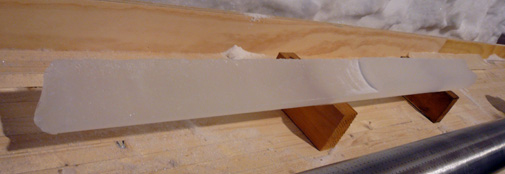The first ice core drilled

Our first core on the table. The core is moon shaped because it is drilled from the transition between the large diameter hole from last year and the smaller diameter of the hole this year.
Outside, the mess continued; but later in the day the wind abated a bit, and we were able to see the effects of the blow. New snowdrifts have formed, several of them more than 1 meter high. We are planning to have flights coming in a few days. Both the U.S. Summit camp and we at NEEM are behind schedule in flights due to the bad weather that has hit the ice sheet in the past three days. To top it off, one Hercules plane is sitting in Kangerlussuaq with a landing gear issue. They might be able to fly tomorrow, but if weather permits, the 109th will first fly to Summit. This suits us fine, as our skiways badly need grooming because of all the fresh snow. As we are in a run-in phase of upgrading our skiways to heavier loads, it is important to us that we have done all we can, before the 109th attempt landing again. As soon as the wind goes down and the snow drift ends, we will start grooming. We drilled the first ice core today. The short drill has since yesterday been used to clean the hole at the bottom some 100 m down. The task has been to remove debris from drilling last year. As we went through the debris we drilled into the ice. As soon as our short drill has drilled a hole deep enough to hold the length of the deep drill, we will change to the deep drill.
What we have done today:
- Cleaned hole with Hans Tausen drill.
- Drilled the first ice core.
- Made carpenter work in drill trench.
- Upgraded electrical supply to main dome.
- No work outside. Too much blowing snow.
Ad.1: This is how the drillers report looks today:
“With the winch control and drill electronics working fine, the Hans
Tausen Drill was mounted to begin clearing the chips that filled the
bottom 13 meters of the borehole following last season’s reaming
operation. Three runs with a 134 mm diameter cutter configuration
successfully brought up about 40 liters of loose chips. With the fourth
run the drill began to penetrate the side wall and virgin ice was brought
to the surface reminiscent of the refrozen “moon” cores produced at the
bottom of NGRIP as we deviated gradually from the original borehole. We
believe the sidewall penetration began when the cutters encountered the
ledge left by the transition between two reamer diameters (reamer 3 and
2). Next, we mounted the conical reamer in place of the drill head with
the hope that the drill would be deflected back into the original
borehole. After two runs, believing we were back in the original bore
hole, we remounted the drill head configured with 127 mm cutter
configuration for a run which produced a 1.32 m “moon” core. This “moon”
core also contained the ledge from the transition between the next set of
reamers (2 and 1). It is now clear that within another meter of
penetration a complete new borehole will be established at a driller’s
depth of about 90 m (~99 m below May 2008 surface defined as zero depth). Preliminary indications are that this new
borehole has an inclination of
about 0.3° which we believe is more plumb than the original borehole. The
way forward is to continue down this new path with the Hans Tausen drill
with 134 mm cutter configuration and reassess the inclination as we go. If acceptable, we will then proceed with
setting up the final
infrastructure in the trench to handle these first ice cores of 2009 and
begin preparations for the test phase of the new deep drill. The overlap
between the new borehole and the bottom of S1-2008 should be approximately
7 meters and precise depth registration should be straight forward with
ECM.”
Weather: Variable from over cast to blue sky, -24°C to -12°C, 10-38 knots
mainly from S and SSE.
Visibility: 200 m to 1 km. Snow and blowing snow.
FL, J.P. Steffensen
| ← Previous entry | Next entry → |

